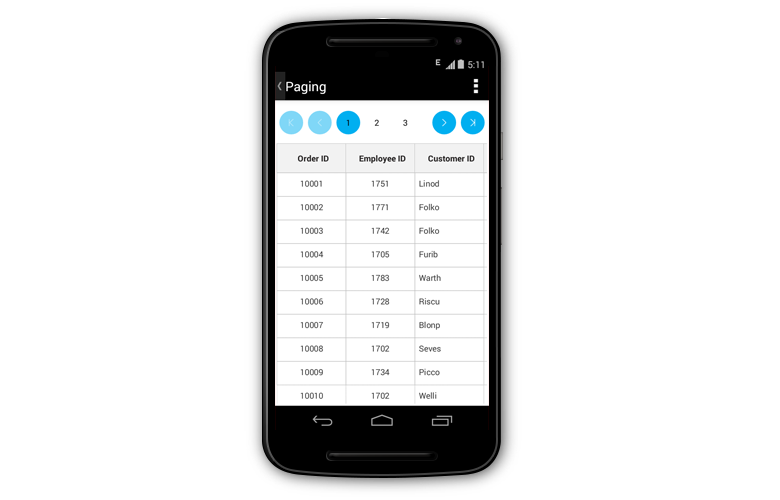Paging
23 Sep 20205 minutes to read
The data grid interactively supports manipulating data using the SfDataPager control. It also provides built-in options to page data on demand when dealing with large volumes of data. The data grid places the SfDataPager above or below to easily manage the data paging.
To use the paging functionality in the data grid, add the Syncfusion.SfDataGrid.DataPager namespace to your project.
Normal paging
The data grid performs data paging using the SfDataPager. Follow this procedure to enable paging in the data grid:
- Create a new SfDataPager instance and bind the data collection to the SfDataPager.Source property, based on which SfDataPager.PagedSource is created internally.
- Bind the
PagedSourceproperty to the ItemsSource of the data grid. - Set the number of rows to be displayed in a page by setting the SfDataPager.PageSize property.
- Set the number of buttons that need to be displayed in view by setting the SfDataPager.NumericButtonCount property.
NOTE
The
SfDataPager.PageSizeproperty should not be assigned with the value of 0.
The following code example shows how to implement paging in the data grid for Xamarin.Android:
public class MainActivity : Activity
{
SfDataGrid sfGrid;
PagingViewModel viewModel;
SfDataPager sfDataPager;
protected override void OnCreate(Bundle bundle)
{
base.OnCreate(bundle);
LinearLayout linearLayout = new LinearLayout(this);
linearLayout.Orientation = Orientation.Vertical;
sfDataPager = new SfDataPager(this);
sfGrid = new SfDataGrid(this);
viewModel = new PagingViewModel();
sfDataPager.PageSize = 15;
sfDataPager.Source = viewModel.OrdersInfo;
sfDataPager.NumericButtonCount = 20;
sfGrid.AutoGeneratingColumn += GridGenerateColumns;
sfGrid.ItemsSource = sfDataPager.PagedSource;
linearLayout.AddView(sfDataPager, new ViewGroup.LayoutParams(ViewGroup.LayoutParams.MatchParent,
(int)SfDataGridHelpers.ConvertDpToPixels(this.sfGrid, 75)));
linearLayout.AddView(sfGrid);
SetContentView(linearLayout);
}The following screenshot shows the outcome upon execution of the above code:

NOTE
The
SfDataPagerprovides scrolling animation when the FirstPageButton or LastPageButton are tapped.
On demand paging
In normal Paging, data collection is entirely loaded to the SfDataPager. However, the data grid also loads the data for the current page dynamically by setting the SfDataPager.UseOnDemandPaging to true.
To load the current page item dynamically, hook the OnDemandLoading event. In the OnDemandLoading event, use theLoadDynamicItems method to load the data for the corresponding page in SfDataPager.
The OnDemandLoading event is triggered when the pager moves to the corresponding page. The OnDemandLoading event contains the following event arguments:
- StartIndex: Defines the corresponding page start index.
- PageSize: Defines the number of items to be loaded in a page.
The following code example illustrates how to load data for the data pager control dynamically:
private void OnDemandPageLoading(object sender, OnDemandLoadingEventArgs args)
{
sfDataPager.LoadDynamicItems(args.StartIndex, source.Skip(args.StartIndex).Take(args.PageSize));
}NOTE
In OnDemandPaging, you cannot assign a value for the Source property in the data pager.
When using OnDemandPaging, the SfDataPager.PagedSource loads only the current page data. Upon navigation to another page, the OnDemandLoading event is fired which loads another set of data but also maintains the previous page data. When navigating to previous page again, the OnDemandLoading event is not fired and the required data is loaded which was maintained in cache. However, for further performance enhancement, if you do not want to maintain the previous page data, you can call Syncfusion.Data.PagedCollectionView.ResetCache() in the OnDemandLoading event. ResetCache method call resets the cache except the current page.
The following code example illustrates how to use ResetCache method:
private void OnDemandPageLoading(object sender, OnDemandLoadingEventArgs args)
{
sfDataPager.LoadDynamicItems(args.StartIndex, source.Skip(args.StartIndex).Take(args.PageSize));
(sfDataPager.PagedSource as PagedCollectionView).ResetCache();
}Custom appearance
The following code example shows how to implement paging with custom appearance in the data grid:
sfDataPager.AppearanceManager = new CustomAppearance();public class CustomAppearance : AppearanceManager
{
public override Color GetNavigationButtonBackgroundColor()
{
return Color.Rgb(34, 34, 34);
}
public override Color GetNumericButtonBackgroundColor()
{
return Color.Rgb(0, 255, 0);
}
public override Color GetNumericButtonForegroundColor()
{
return Color.Rgb(82, 82, 82);
}
public override Color GetNumericButtonSelectionBackgroundColor()
{
return Color.Rgb(255, 0, 0);
}
public override Color GetNumericButtonSelectionForegroundColor()
{
return Color.Rgb(0, 0, 255);
}
}The following screenshot shows the outcome upon execution of the above code:
